Takayama was the next city we visited during our Japanese trip. This was one of the most anticipated parts of our itinerary. We had heard a lot about the Takayama Festival, held in spring and autumn. The Spring Festival takes place every year on the 14th and 15th of April and we really wanted to experience what is considered one of Japan’s best festivals. That’s why we basically built the full holiday around it, so that we could be in Takayama on the 14th. Here is my little Takayama guide.
Takayama is a beautiful little town in the mountainous Hida region. It has a nicely preserved old town and is a great example of what rural Japan is like.

We arrived on the 13th of April by train from Kanazawa and the last part of the journey is spectacular. The train passes from the Japanese “Alps”. Being Italian, I am very familiar with the “real Alps” and I can tell you that these Japanese mountains look quite similar. We passed some breathtaking landscapes: valleys, rivers, dams, waterfalls, little villages. If I hadn’t known better, I would have thought we were travelling through the Dolomites. It was the middle of April, yet there was snow everywhere, which brought quite a bit of excitement to my Australian daughters who are not that familiar with “real winter”.
After settling into our beautiful ryokan, we started our sightseeing. We decided to cover as much as possible on the first day, so we could be free to experience what the festival had to offer the following day.
SIGHTSEEING

We started our visit from the old town that has been beautifully preserved with many buildings and whole streets of houses dating from the Edo Period.

I particularly liked the Sannomachi Street, with plenty of old homes, shops, coffee houses and sake breweries, some of which have been in business for centuries.

Sake is one of Takayama’s specialties and you can find several old sake breweries in the old town. Make sure to sample some sake! We also bought a pretty sake bottle in one of these shops.
I also found the miso shop quite interesting.

Some homes are open to the public and they provide a glimpse into the living quarters of the local merchants in ancient times. The Kusakabe Heritage House is one of Takayama’s oldest merchant homes open to the public. Its former residents used to be successful money lenders. Standing right next door is the Yoshijima Heritage House, also open to the public.


Two morning markets are held in Takayama on a daily basis, one is in front of the Takayama Jinya (Takayama’s government office during the Edo Period) and one along Miyagawa River.



Most stands sell local crafts and farm products such as vegetables, pickles and flowers.


I tasted some amazing dried blueberries!

As it was raining heavily, we did not find the markets as lively as we had expected, but it could also have been because of the festival.


Takayama is quite a pretty town. I loved the river that cuts through it and all the little bridges that connect the two sides of the town.



Also, Takayama is famous for its amulet sarubobo, red human-shaped dolls, traditionally with no facial features. We bought a small one to hang on our Christmas tree… but this one was huge!

Another very nice place to visit is the Hida Folk Village (Hida no Sato). It is an open air museum exhibiting over 30 traditional houses from the Hida region. The houses were built during the Edo Period and were relocated from their original locations to create the museum. Unfortunately, we did not have time to visit it.

THE TAKAYAMA FESTIVAL
The Takayama Festival is one of Japan’s three most beautiful festivals together with Kyoto’s Gion Matsuri and the Chichibu Yomatsuri. It is held twice a year, in spring and autumn in the old town and attracts a lot of people!
We experienced the Spring Festival (held every year on the 14th and 15th of April). It is the annual festival of the Hie Shrine.

Both the spring and autumn festivals have similar attractions and schedules. Each festival features its festival floats (called yatai). During the year, the tall and heavily decorated floats are stored in storehouses, scattered across the old town. At any time of the year you can also see a set of floats at the Matsuri no Mori festival museum.
During the day of the festival, the floats are displayed at various locations. We were not lucky at all weather-wise and what happens when it rains is that the floats remain in their storehouses, but the doors of the storehouses are opened so that people can still see them.

Several of the festival floats are decorated with karakuri ningyo, sophisticated mechanical dolls that can move and dance. Karakuri doll performances are held on both days of the festival at specific times and places.

A portable shrine (called mikoshi) is paraded around the town, starting and ending at the festival’s shrine. The mikoshi contains the shrine’s Shinto deity.
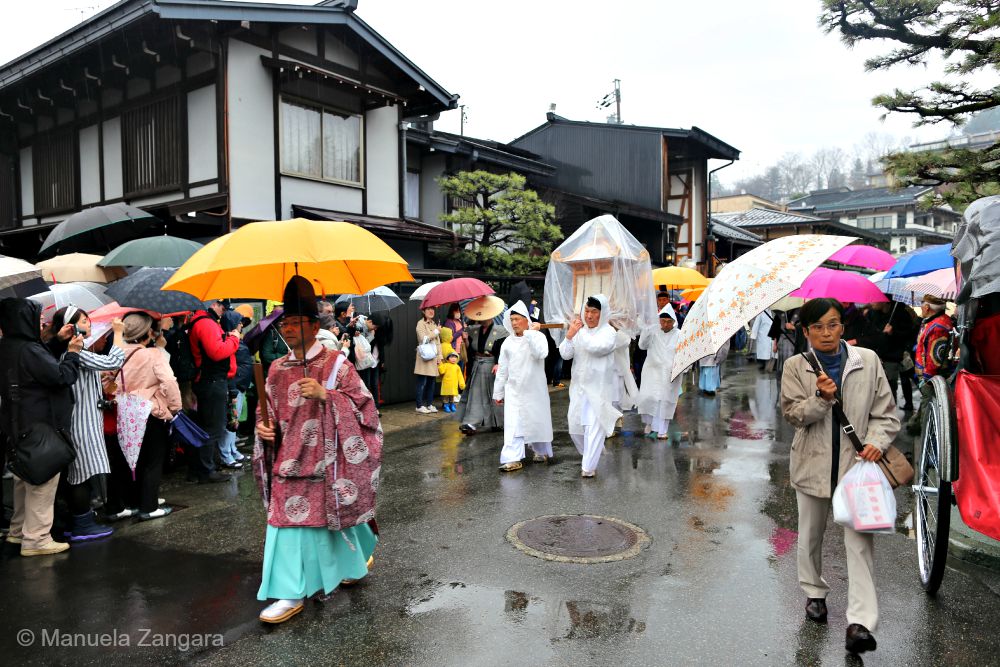
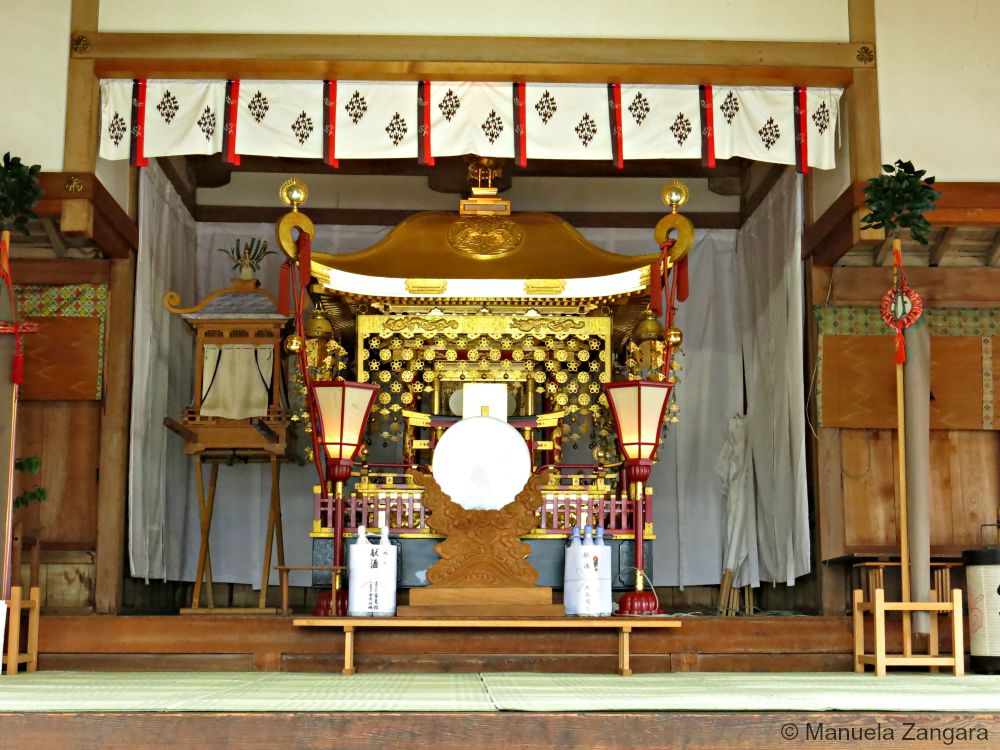
There is also music played by people dressed up in traditional clothes.
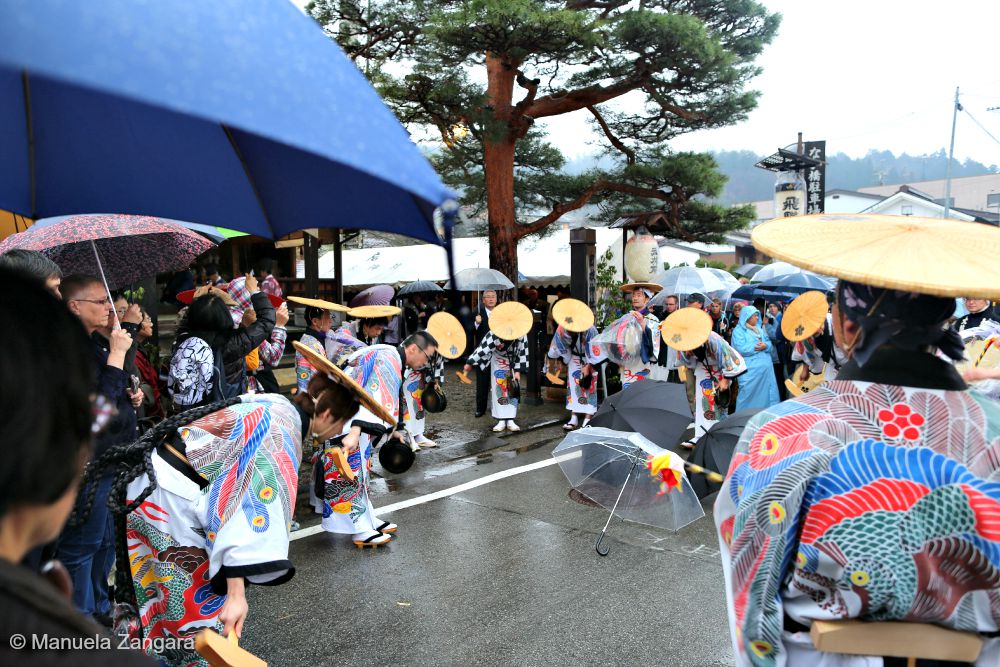
And we even saw the “dragon dance”. The girls particularly liked this.
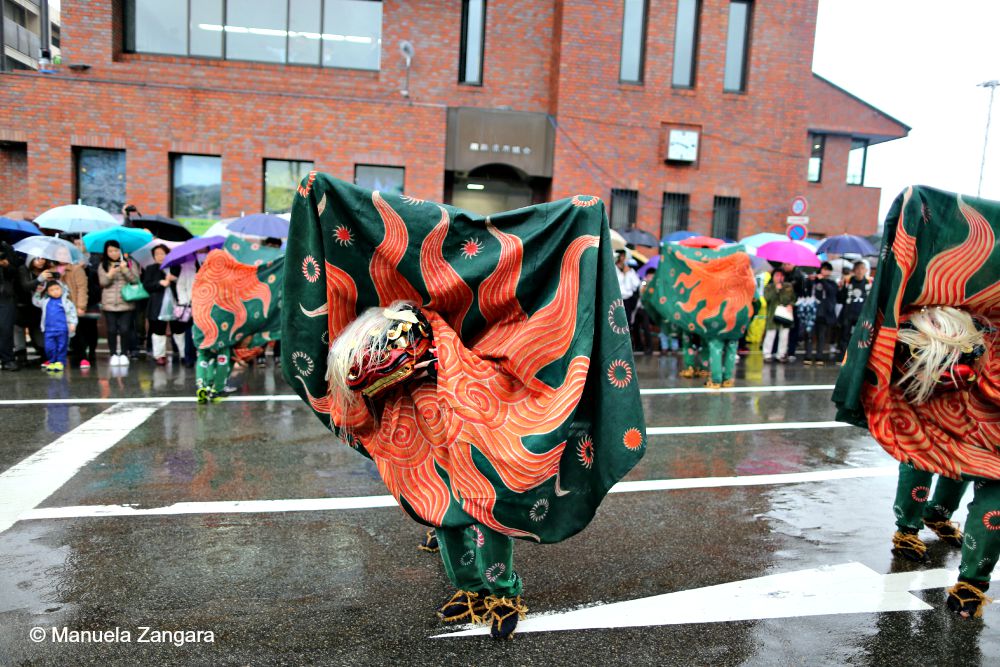
Usually, there is also an “evening festival” the night of the first day. During this time, the floats are pulled through the streets of Takayama’s old town for a couple of hours. Unfortunately, this was cancelled because of the heavy rain.
Check out my short video of the Festival.
FOOD
Besides being famous for its sake, Takayama is also well known for its beef, called Hida beef. If you have only eaten what is known as “wagyu” beef outside of Japan… forget it. It doesn’t even come close to real Japanese beef. Hida beef (like Kobe beef) has a beautiful marbling and it is quite high in fat. This marbled fat coats the meat when cooked and it helps keeping the meat juicy. Actually… it is so soft that it literally melts in your mouth.

We had a Hida beef dinner at Maruaki. They also have a butchery attached to it, where you can see (and buy) all the cuts they have.
They have big tables with a grill in the middle, so you can cook your own meat (and vegetables). It is quite a fun experience and I highly recommend it.

We ordered a mixed plate (300 grams): cubed beef, beef strips and a grade A sirloin with vegetables and some sliced sirloin for the girls. It was AMAZING.

Even the girls who usually do not eat “steak” liked it so much that we had to order some more!

The meat is so tender… it simply disappears in your mouth. We spent about $150 for the whole meal, but for what we ate is rather cheap!
As it was “festival time”, there was plenty of street food too.

The second night, we decided to find an izakaya for dinner… Our ryokan is very well organised and they have a printout with all nearby restaurants and a map to find them. We first went to Taruhei which comes highly recommended. We walked for 10 minutes under the rain and when we got there, we found out we are not welcome. Yes. When we opened the door, they gave us a somewhat weird look… then they started talking Japanese to us. As we obviously could not understand, a lady who is eating there translates. Basically they told us, we could not eat there because they didn’t have an English menu. We told them it was ok, we could manage it (we had been in Japan for 2 weeks already… and we had ordered food from non-English menus already). Silence. Then the lady owner told us to go… it was already full. Mmmmm we could see so many empty spots it was not really convincing. Anyhow, we didn’t really want to give our money to them anymore… so we went away. My thinking is they did not want the kids. I have heard about some places not welcoming children in Japan. I think it’s nuts, but if it’s their policy, I accept it. I just would like them to be clear and polite about it.
Anyhow, we ended up eating at another izakaya, just behind the hotel and we were really lucky. This place was amazing. The ladies who worked here were very friendly and welcoming. They didn’t speak a word of English, but we could still communicate. The clients were nice too… great atmosphere.

And, the food was delicious. We had beef korokke, mixed yakitori (including chicken liver and Hida beef sirloin), fried chicken wings and beer.

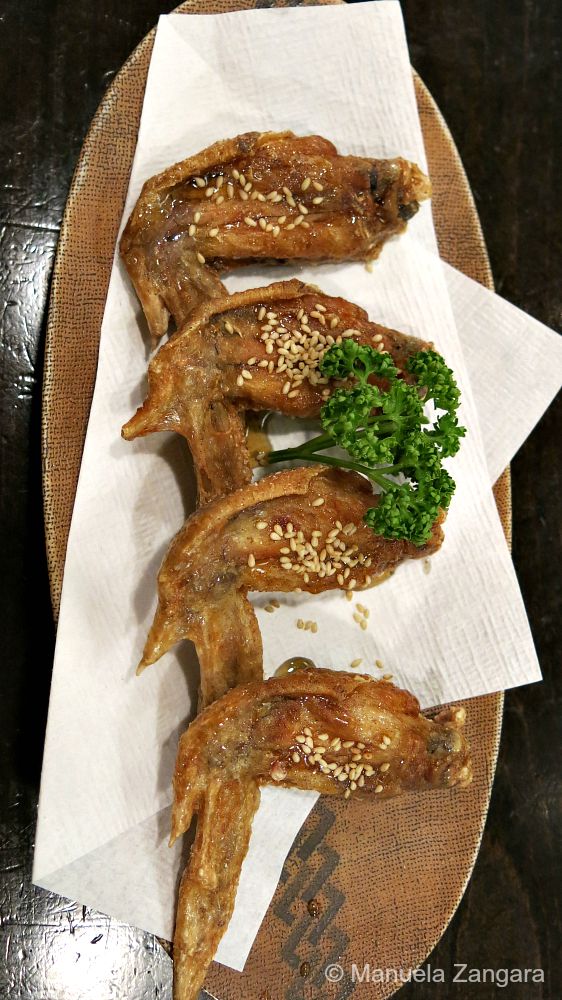
It was a feast! This place is called Hida yansa. Highly recommended.
ACCOMMODATION
In Takayama, we stayed in a very nice ryokan called Asunaro.

The ryokan is in a very good spot. It’s between the station and the old town. Also remember that Takayama is quite small and you can get anywhere on foot. It is also in a very quiet area.
We had a fantastic experience from the moment we arrived till the moment we left. We were greeted by the lovely staff with dry towels (remember it was pouring!!) and they immediately checked us in. We had sent our luggage from Kyoto and we found it in our room.
The room itself wasn’t as big as the one of Kanazawa and the fact that the futons would not be removed during the day (unlike in Kanazawa) did not help. Also, the furniture looked a bit “tired”. So don’t expect a posh ryokan. Still, it’s full of charm and character and very clean. Also, note that we chose a “medium priced room” with a private toilet and bath.

As always, we had a Yukata each to wear for the night and all the usual toiletry sets you find in Japanese hotels, like toothbrushes and toothpaste, razors etc…

My favourite part of the room was the verandah where we had a table and chairs, so we could relax and sit comfortably to have tea and cookies.

The reception was very nice. There was a big irori – a traditional Japanese sunken hearth – on one side and an espresso machine with free coffee for the guests on the other side (and as an Italian in terrible need of caffeine, that was AMAZING).

To book, I sent an email directly to the hotel, but you can also check Booking.com or HotelsCombined to see if they have any better prices.
If you are planning on visiting Takayama during the festival, be prepared to have a hard time booking your accommodation. Many hotels start to take reservations only 6 (some 3!) months before the festival and they fill up really quickly. So do your inquiries ahead of time, pick 2 or 3 places you like and then put a reminder to make your booking. Do not leave it to the last moment.
I highly recommend Ryokan Asunaro for the comfort of the room and the location. But above all, I recommend it for its staff. They are amazing and they really care about their guests. On the last day (it was still raining), they just volunteered to drive us to the station… for free and without us asking. And, they had a little present for each member of our family too! This is definitely the place where we will be staying at on our next visit to Takayama.
RESOURCES ON MSM
RECIPES:
TRAVEL IN JAPAN:
Nara & Fushimi Inari guide – Japan
HOW TO GET THERE
You can easily get to Takayama by train. From Tokyo you can travel to Nagoya or Toyama on a Shinkansen and transfer to the JR Hida limited express train to Takayama.
We travelled from Kanazawa to Toyama on a Shinkansen and transferred to the JR Hida limited express train to Takayama.

MAP
*In the spirit of full disclosure, this post contains some affiliate links, which means that I may get a commission if you decide to purchase anything from my partners’ sites.





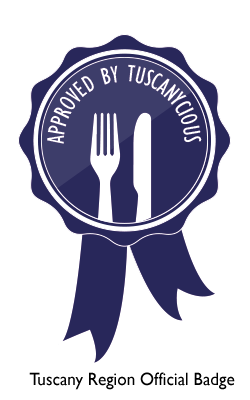












Look at those awesome marbling on the beef! And the miso shop look so interesting to find there. Thank you so much for sharing. Love the shots!!
Julie & Alesah
Gourmet Getaways xx